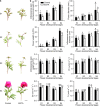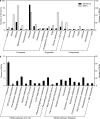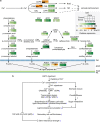EGTA reduces the inflorescence stem mechanical strength of herbaceous peony by modifying secondary wall biosynthesis
- PMID: 30854212
- PMCID: PMC6395589
- DOI: 10.1038/s41438-019-0117-7
EGTA reduces the inflorescence stem mechanical strength of herbaceous peony by modifying secondary wall biosynthesis
Abstract
The mechanical strength of inflorescence stems is an important trait in cut flowers. Calcium ions (Ca2+) play a pivotal role in maintaining stem strength, but little is known about the underlying molecular mechanisms. In this study, we treated herbaceous peony (Paeonia lactiflora Pall.) with ethyl glycol tetraacetic acid (EGTA), an effective Ca2+ chelator, and used morphology indicators, spectroscopic analysis, histochemical staining, electron microscopy, and proteomic techniques to investigate the role of Ca2+ in inflorescence stem mechanical strength. The EGTA treatment reduced the mechanical strength of inflorescence stems, triggered the loss of Ca2+ from cell walls, and reduced lignin in thickened secondary walls in xylem cells as determined by spectroscopic analysis and histochemical staining. Electron microscopy showed that the EGTA treatment also resulted in significantly fewer xylem cell layers with thickened secondary walls as well as in reducing the thickness of these secondary walls. The proteomic analysis showed 1065 differentially expressed proteins (DEPs) at the full-flowering stage (S4). By overlapping the Kyoto encyclopedia of genes and genomes (KEGG) and gene ontology (GO) analysis results, we identified 43 DEPs involved in signal transduction, transport, energy metabolism, carbohydrate metabolism, and secondary metabolite biosynthesis. Using quantitative real-time polymerase chain reaction (qRT-PCR) analysis, we showed that EGTA treatment inhibited Ca2+ sensors and secondary wall biosynthesis-related genes. Our findings revealed that EGTA treatment reduced the inflorescence stem mechanical strength by reducing lignin deposition in xylem cells through altering the expression of genes involved in Ca2+ binding and secondary wall biosynthesis.
Conflict of interest statement
The authors declare that they have no conflict of interest.
Figures






Similar articles
-
Transcriptome and weighted correlation network analyses provide insights into inflorescence stem straightness in Paeonia lactiflora.Plant Mol Biol. 2020 Feb;102(3):239-252. doi: 10.1007/s11103-019-00945-4. Epub 2019 Dec 12. Plant Mol Biol. 2020. PMID: 31832900
-
Integration of Transcriptome, Proteome, and Metabolome Provides Insights into How Calcium Enhances the Mechanical Strength of Herbaceous Peony Inflorescence Stems.Cells. 2019 Jan 30;8(2):102. doi: 10.3390/cells8020102. Cells. 2019. PMID: 30704139 Free PMC article.
-
Effects of inflorescence stem structure and cell wall components on the mechanical strength of inflorescence stem in herbaceous peony.Int J Mol Sci. 2012;13(4):4993-5009. doi: 10.3390/ijms13044993. Epub 2012 Apr 19. Int J Mol Sci. 2012. PMID: 22606025 Free PMC article.
-
Secondary cell walls: biosynthesis, patterned deposition and transcriptional regulation.Plant Cell Physiol. 2015 Feb;56(2):195-214. doi: 10.1093/pcp/pcu140. Epub 2014 Oct 7. Plant Cell Physiol. 2015. PMID: 25294860 Review.
-
A review of xylan and lignin biosynthesis: foundation for studying Arabidopsis irregular xylem mutants with pleiotropic phenotypes.Crit Rev Biochem Mol Biol. 2014 May-Jun;49(3):212-41. doi: 10.3109/10409238.2014.889651. Epub 2014 Feb 24. Crit Rev Biochem Mol Biol. 2014. PMID: 24564339 Review.
Cited by
-
Effect of the pectin contents and nanostructure on the stem straightness of two Paeonia lactiflora cultivars.PeerJ. 2023 Apr 13;11:e15166. doi: 10.7717/peerj.15166. eCollection 2023. PeerJ. 2023. PMID: 37073273 Free PMC article.
-
Evaluating the Comprehensive Performance of Herbaceous Peonies at low latitudes by the Integration of Long-running Quantitative Observation and Multi-Criteria Decision Making Approach.Sci Rep. 2019 Oct 21;9(1):15079. doi: 10.1038/s41598-019-51425-0. Sci Rep. 2019. PMID: 31636314 Free PMC article.
-
Transcriptome provides potential insights into how calcium affects the formation of stone cell in Pyrus.BMC Genomics. 2021 Nov 17;22(1):831. doi: 10.1186/s12864-021-08161-5. BMC Genomics. 2021. PMID: 34789145 Free PMC article.
-
Transcriptome and weighted correlation network analyses provide insights into inflorescence stem straightness in Paeonia lactiflora.Plant Mol Biol. 2020 Feb;102(3):239-252. doi: 10.1007/s11103-019-00945-4. Epub 2019 Dec 12. Plant Mol Biol. 2020. PMID: 31832900
-
Color characteristics, pigment accumulation and biosynthetic analyses of leaf color variation in herbaceous peony (Paeonia lactiflora Pall.).3 Biotech. 2020 Feb;10(2):76. doi: 10.1007/s13205-020-2063-3. Epub 2020 Jan 28. 3 Biotech. 2020. PMID: 32051809 Free PMC article.
References
-
- Zhang CY, Shi WS, Ma KS, Li HJ, Zhang FX. EGTA, a calcium chelator, affects cell cycle and increases DNA methylation in root tips of Triticum aestivum L. Acta Soc. Bot. Pol. 2016;85:3502.
-
- Bakeer SM. Effect of ammonium nitrate fertilizer and calcium chloride foliar spray on fruit cracking and sunburn of Manfalouty pomegranate trees. Sci. Hortic. 2016;209:300–308.
-
- Xu DH, et al. Calcium alleviates decreases in photosynthesis under salt stress by enhancing antioxidant metabolism and adjusting solute accumulation in Calligonum mongolicum. Conserv. Physiol. 2017;5:1–8.
LinkOut - more resources
Full Text Sources
Miscellaneous

